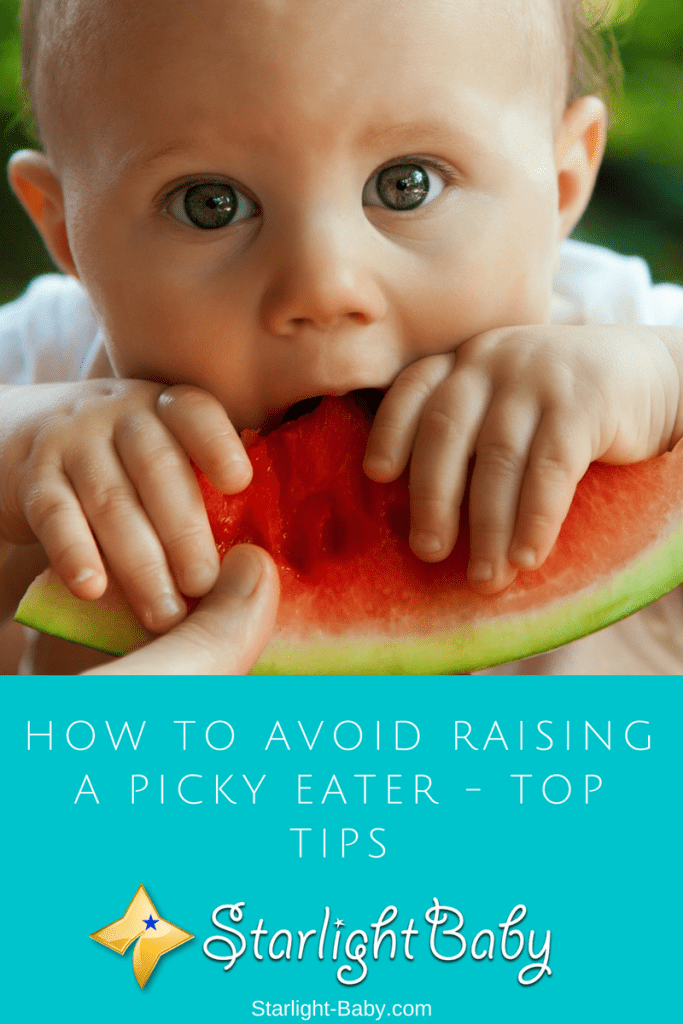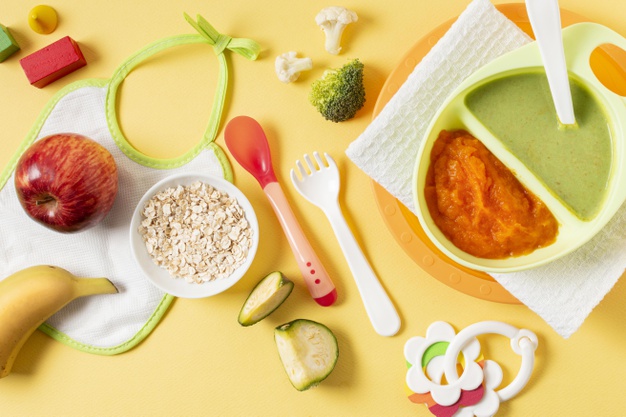 Are you hoping to raise an adventurous eater? If so, you’re definitely not alone.
Are you hoping to raise an adventurous eater? If so, you’re definitely not alone.
You’ve likely heard all about the meal time battles parents constantly have with their toddlers and young children. They refuse to try new foods, throw a tantrum if they don’t get their favorite crackers and in some cases, throw an Oscar-winning performance of pretending to gag and be sick.
It doesn’t sound much fun does it! So, what can you do to avoid it and are there things you can do throughout the baby stage to ensure your little one turns into an adventurous eater?
How Soon Can You Start Encouraging Adventurous Eating?
 The main question parents have in terms of introducing healthy eating habits is at what age should you start? It might surprise you to learn that healthy eating can be encouraged from the womb.
The main question parents have in terms of introducing healthy eating habits is at what age should you start? It might surprise you to learn that healthy eating can be encouraged from the womb.
Before your little one is even born, they ingest fluid from the womb. The amniotic fluid contains flavors passed on from the food that you eat. So, if you eat plenty of fruits and vegetables, your baby will become accustomed to the flavors and become less likely to refuse to eat them later down the line.
This transferring of healthy foods also occurs during breastfeeding. So, if you want your baby to turn into an adventurous eater, you need to be one yourself.
The Benefits Of Making Your Own Baby Food
You’ll likely know from your own experience of eating processed and fresh vegetables, that they taste much better when they’re fresh. The same applies to canned baby foods. The fruits and vegetables contained within canned baby food tastes nothing like how it does fresh.
You can create batches of fresh baby food in advance and it isn’t actually as expensive as you might think. A good tip is to steam the vegetables before you place them in the blender to ensure they are nice and soft. You can freeze fresh homemade baby food and simply defrost it in luke-warm water as and when it is needed.
When your baby is around nine months old, you can also start adding other flavors contained in herbs and spices. The earlier you introduce fresh fruits and vegetables into your little one’s diet, the less trouble you’re going to have once they reach the toddler stage.
Keep It Simple
While you obviously want to expose your baby to as many different delicious foods as possible, it’s important to start out simple. Give them one-ingredient purees for example, such as banana puree or peas. If you start adding too many ingredients, you’ll just end up overwhelming your little one and that’s when they may start to refuse things.
It also helps to keep a very open mind. It’s common for parents to worry about their baby’s reaction when they’re introducing something new. However, if you remove that mindset and ensure you appear happy during mealtimes, rather than concerned, you should find your baby is much more willing to try the foods, and enjoy them.
Limit White Foods
Did you know that the majority of young children who are picky eaters are largely used to eating white foods? The trouble with these popular white foods such as bread, is that they tend to be very bland. They contain very few nutrients, if any, and really dull the taste buds, making healthier, flavorsome foods taste horrible.
Instead of feeding baby white bread, offer them whole grain, nutty toast. Switch white pasta to whole wheat pasta and switch white potatoes for sweet potatoes. These simple changes can have a dramatic impact on how adventurous your little one’s taste buds become.
Opt For Colorful Foods
After you’ve cut out white foods, stock up on as many different colored foods as you can. You can make the different colors a fun part of dinner time, counting how many are on the plate and getting baby excited about them. Once they reach the toddler stage, they’ll be so excited to count how many colors they’re eating and may even brag to their friends and family about it afterwards.
Different colored foods contain different nutrients. Did you know for example that red apples contain different nutrients to green apples? That’s why it’s always recommended by nutritionists to make sure there’s plenty of different colored foods added to your grocery basket.
Always Offer At Least One Thing They Like
When baby is eating solids and you have a good idea of what they already like, it’s important to offer anything new, alongside one thing they love. That way, you aren’t overwhelming them with a mysterious new food and they’ll feel safer seeing there’s something there that they actually like.
Keep The Portion Sizes Small
The main thing you need to remember when trying baby with new foods, is to keep the portion sizes small. Your little one only has a very tiny tummy, so don’t be discouraged if they only eat one or two mouthfuls of the new food. You can always try again later.
Plus, if you serve up only a tiny portion of a new food, you won’t end up wasting it if they really don’t like it.
Focus On Adding Savory Foods
Most babies have a naturally sweet tooth, so getting them to try new fruits for example, is never as much of an issue as introducing savory foods. So, if you really want to turn them into an adventurous eater, ensure you focus on offering them different savory foods.
You can blend vegetables such as spinach and broccoli, into fruit smoothies to begin with. It’s also a good idea to try Sauté garlic and onions. Flakey fish such as tuna or salmon can then be introduced once you are given the go-ahead from your pediatrician.
Conclusion
These are the best tips to help encourage baby to go on to become a more adventurous eater. However, it’s worth keeping in mind these aren’t fool-proof tips. Try as you might, you may still find yourself facing mealtime battles with your toddler and young child. It’s actually a natural part of development for toddlers to become picky eaters. You may even find they start refusing foods they have previously loved.
It’s pointless fighting against these occasional food battles and it doesn’t mean you’ve done anything wrong during the baby stage. Overall, if you follow the tips above, your little one is a lot more likely to go on to become an adventurous eater.
 Once
Once
In our culture, we do not introduce solid food until the baby is 5 months old. An elaborate ceremony is held for the baby’s first food ceremony. After the food ceremony, the baby is given solid food. My baby is 5 months old, and in few days, we are organizing the feeding ceremony. In our tradition, making baby food at home is highly recommended. We include rice, wheat, corn, soya and milk cream in our baby food. I don’t know what kind of taste our baby will develop, however, I will make sure that he will eat all kinds of nutricious food.
Timing is everything when it comes to baby eating habits and how they choose which food to be comfortable consuming. Babies can be picky when it comes to some food but how a parent go about this, would help in getting the baby to enjoy mostly anything given to it.
When a child isn’t too picky with food, such baby looks healthy and plumpy because they get almost all the nutrients needed for their entire body growth and development. It’s noticed that some kids don’t fancy having vegetables in their meal, and it’s very much aware how vegetables can be very good for baby’s consumption. All a parent need to do is find a way to mash up the vegetables and make it almost invincible to their eyes.